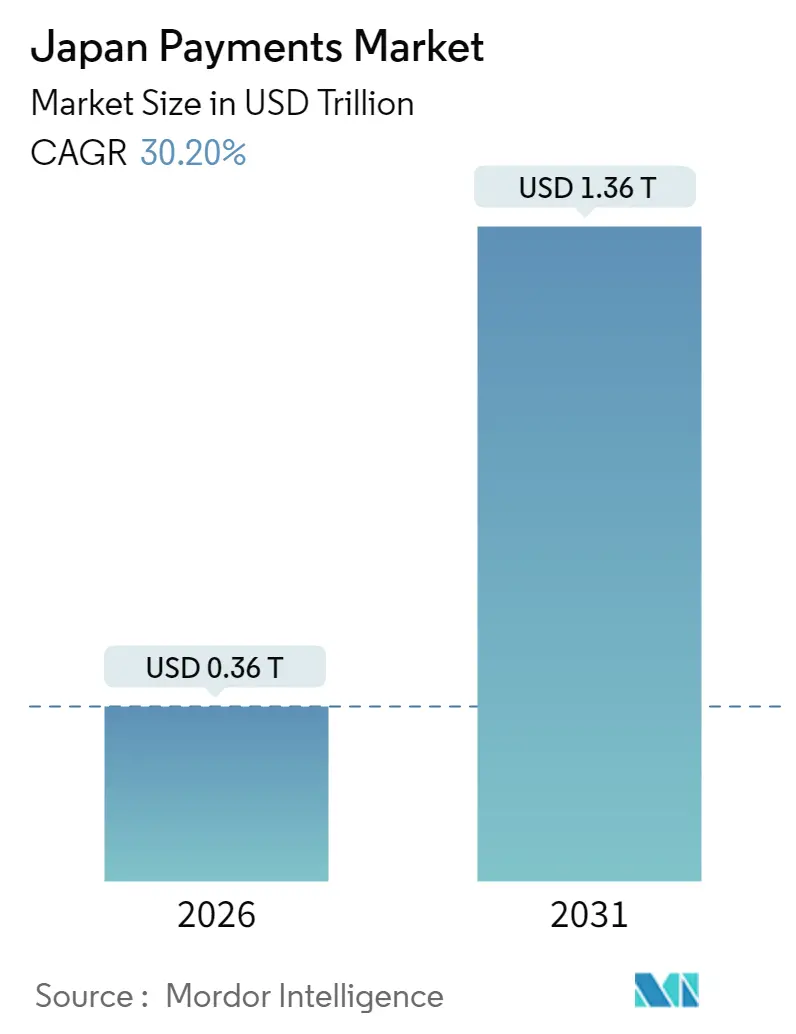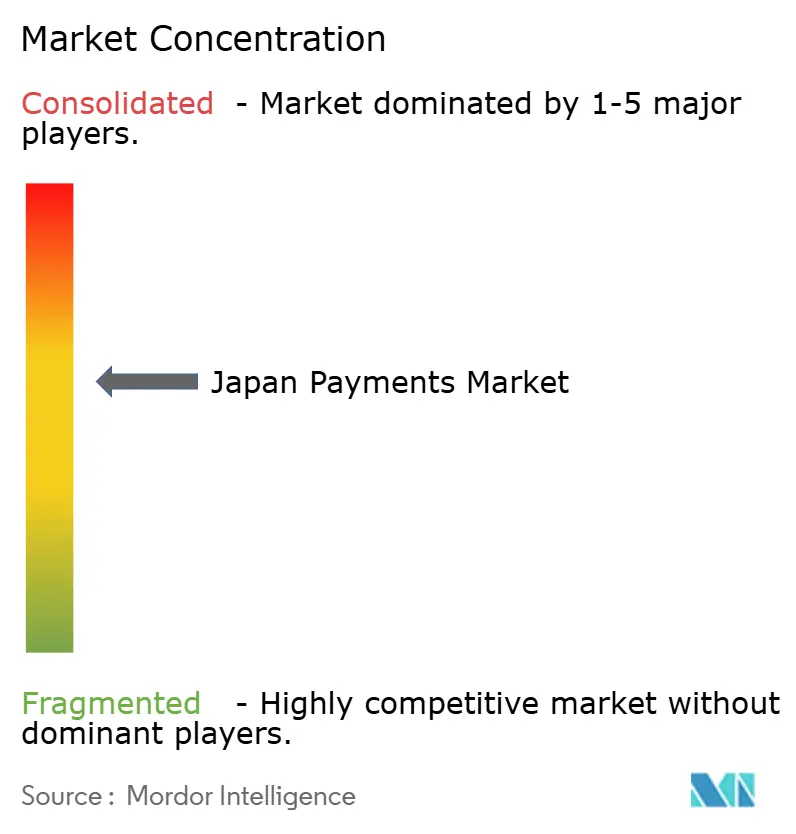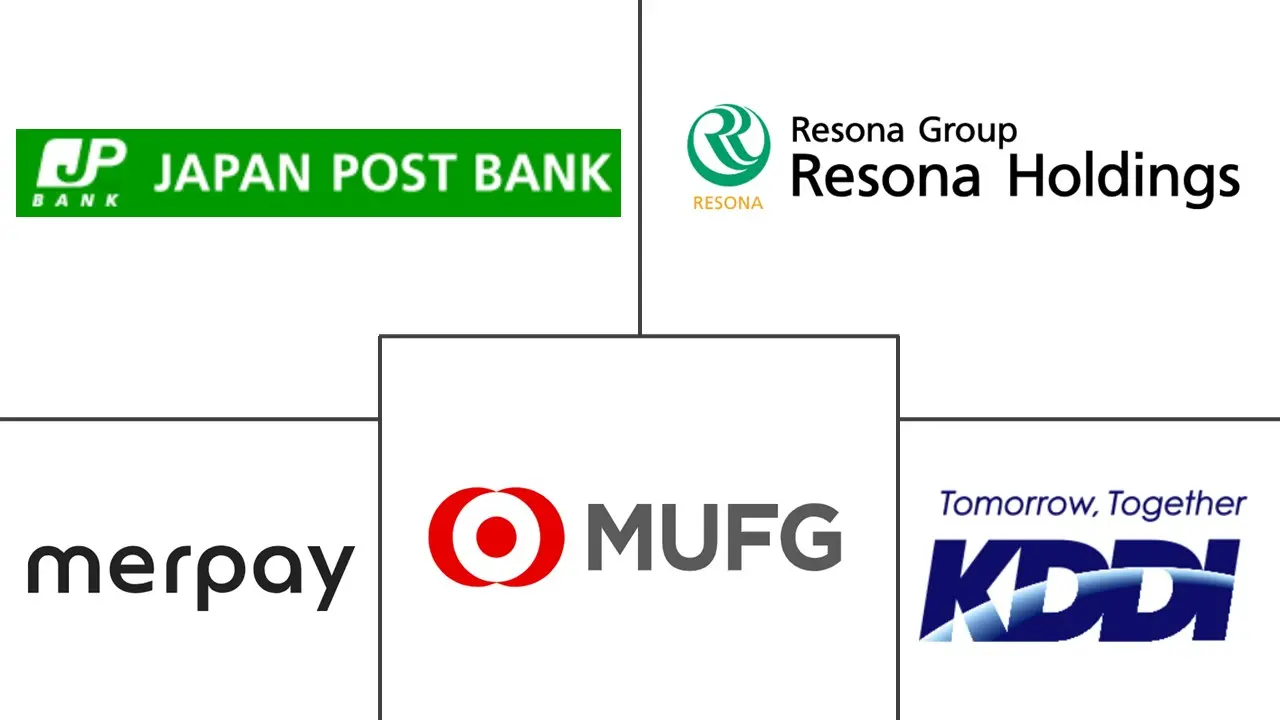
Japan Payments Market Analysis by Mordor Intelligence
The Japan payments market is expected to grow from USD 280 billion in 2025 to USD 364.56 billion in 2026 and is forecast to reach USD 1363.06 billion by 2031 at 30.2% CAGR over 2026-2031. The acceleration reflects an orchestrated policy-technology flywheel in which cabinet-level digitization mandates, telco-backed super-apps, and the Bank of Japan’s digital-yen pilot reinforce one another. PayPay’s QR dominance, the Zengin real-time network’s modernization, and a payroll-digitalization decree that enables salary disbursement to funds-transfer providers collectively anchor merchant acceptance momentum. Simultaneously, demographic realities, 29.18% of citizens are 65 years or older, shift adoption drivers away from convenience and toward necessity as seniors embrace e-payments for healthcare, municipal levies, and remittances. These forces position the Japan payments market on a structural, not cyclical, growth curve that is diverging from incremental cashless journeys in many Western nations.
Key Report Takeaways
- By mode of payment, credit cards led with 32.05% of Japan payments market share in 2025, while account-to-account rails are advancing at a 31.15% CAGR through 2031.
- By end-user industry, retail captured 37.12% of the Japan payments market size in 2025 and healthcare is forecast to expand at a 31.62% CAGR between 2026-2031.
Note: Market size and forecast figures in this report are generated using Mordor Intelligence’s proprietary estimation framework, updated with the latest available data and insights as of January 2026.
Japan Payments Market Trends and Insights
Drivers Impact Analysis
| Driver | (~) % Impact on CAGR Forecast | Geographic Relevance | Impact Timeline |
|---|---|---|---|
| Adoption of Online Payments | +8.2% | National, with urban concentration in Tokyo, Osaka, Nagoya metropolitan areas | Short term (≤ 2 years) |
| Government-led Cashless Incentives | +7.5% | National, with targeted rural and elderly demographic programs | Medium term (2-4 years) |
| Ubiquitous Smartphone and 5G Connectivity | +6.8% | National, with 5G infrastructure prioritizing major cities and industrial zones | Medium term (2-4 years) |
| E-commerce Boom and Embedded Checkout | +5.9% | National, with cross-border e-commerce growth in Asia Pacific markets | Short term (≤ 2 years) |
| Super-App Ecosystems by Telcos and E-commerce Majors | +4.7% | National, with competitive intensity in urban markets | Long term (≥ 4 years) |
| Digital-Yen (CBDC) Pilot Accelerating A2A Rails | +3.4% | National pilot programs, with potential regional rollout variations | Long term (≥ 4 years) |
| Source: Mordor Intelligence | |||
Adoption of Online Payments
Embedded checkout adoption allows merchants to bypass traditional interchange structures, shifting value toward data ownership and reinforcing the Japan payments market’s pivot to low-cost rails. Urban retailers integrating Zengin instant transfers cut processing fees by 50-60%, freeing capital for loyalty incentives. The resulting feedback loop boosts average ticket sizes and increases A2A share of in-store digital flows. Cross-border e-commerce merchants likewise leverage direct-to-bank settlement to minimize currency-conversion layers, embedding Japan payments market advantages across regional APAC trade corridors. Financial Services Agency (FSA) guidelines that legitimize payroll disbursement to e-money accounts further widen the consumer on-ramp.
Government-Led Cashless Incentives
The Cabinet Office’s 40% cashless target was surpassed in 2024 when the cashless ratio reached 42.8% on the back of My Number integration subsidies.[1]Cabinet Office, “Cashless Roadmap,” meti.go.jp Municipal digital currencies, such as Hashimoto City’s premium 20% cashback program that injected JPY 600 million (USD 4.2 million) into local retailers- create localized network effects. The initiatives lower merchant cost barriers during critical infancy phases, accelerating the Japan payments market toward critical mass in rural geographies.
Ubiquitous Smartphone and 5G Connectivity
Nationwide 5G coverage unlocks biometric authentication at scale. NEC’s MYAKU-PE system, to be showcased at Expo 2025, processes face-pay transactions in sub-200 milliseconds, removing contact friction. Combined with a 91.6% smartphone adoption rate cited by internal telcos, the infrastructure enables omnichannel strategies where physical and digital payments converge. As telco super-apps exploit device-native NFC and secure elements, the Japan payments market extends beyond QR dependence into invisible, context-aware payments.
E-Commerce Boom and Embedded Checkout
Japan’s konbini settlement heritage gives merchants hybrid cash-digital flows; however, embedded APIs now reconcile those transactions instantly in core accounting systems. Retailers report a 15-point improvement in cart-to-conversion on embedded gateways compared with redirect flows, magnifying topline impact. Meanwhile, supply-chain vendors integrate invoices directly into enterprise resource portals, triggering automated A2A remittance upon goods-receipt confirmation, thereby compressing working-capital cycles in the Japan payments market.
Restraints Impact Analysis
| Restraint | (~) % Impact on CAGR Forecast | Geographic Relevance | Impact Timeline |
|---|---|---|---|
| Ageing Population's Cash Preference | -4.2% | National, with higher impact in rural prefectures and traditional commercial districts | Long term (≥ 4 years) |
| Consumer Data-Privacy Concerns | -3.1% | National, with heightened sensitivity in urban professional demographics | Medium term (2-4 years) |
| QR-Code Scheme Interoperability Gaps | -2.8% | National, affecting cross-regional commerce and tourist transactions | Short term (≤ 2 years) |
| Thin Merchant Margins on Micropayments | -1.9% | National, with acute impact on small retailers and service providers | Medium term (2-4 years) |
| Source: Mordor Intelligence | |||
Aging Population’s Cash Preference
Nearly one-third of citizens are 65 years or older, and many regard cash as a hedge against deflation-era banking shocks. Rural merchants allege that digital tender acceptance costs erode thin margins, reinforcing cash inertia. Yet healthcare digitization and government benefit disbursement via e-money accounts compel seniors to adopt QR or NFC wallets for prescription copays and municipal taxes. Pilot programs using font-magnified interfaces and voice prompts indicate conversion rates up to 28% among prior cash-only seniors, outlining a pathway for inclusive expansion of the Japan payments market.
Consumer Data-Privacy Concerns
FSA’s tighter AML/CFT requirements require granular user-level metadata, intensifying anxiety over transaction surveillance. Corporate data breaches involving loyalty-point fraud amplify mistrust. Providers counter by deploying differential-privacy tokenization and user-selectable data-sharing tiers. Still, opt-out rates for personalized offers rose to 17% in 2025, trimming cross-sell revenue. Balancing compliance with user autonomy becomes essential for sustained trust in the Japan payments market.
Segment Analysis
By Mode of Payment: A2A Rails Reshape Settlement Economics
Account-to-account transfers are growing at a 31.15% CAGR, eclipsing legacy card growth and carving a rising slice of the Japan payments market size as they capitalize on Zengin’s instant clearing enhancements. Merchants that migrate in-app payments to A2A rails reduce fees from 2.5% to below 0.5%, generating material EBIT uplift and redirecting savings into price promotions that further stimulate transaction volume.
Credit cards still hold 32.05% of 2025 transaction value, but contactless penetration already reached 47% of card swipes, suggesting that consumer habit persistence coexists with underlying rail substitution. Super-app wallets overlay both cards and A2A, enabling shoppers to toggle between rails according to cashback tiers. Consequently, the Japan payments market share mix will likely balance rather than fully cannibalize over the forecast horizon.

Note: Segment shares of all individual segments available upon report purchase
By End-User Industry: Healthcare Digitization Drives Sectoral Transformation
Telemedicine rule changes and e-prescription mandates push healthcare payments toward digital wallets and instant transfers, propelling a 31.62% CAGR and enlarging the segment’s contribution to the overall Japan payments market share. Hospitals adopting PayPay’s QR solution reported a 25% reduction in cash-handling overhead, freeing staff for clinical tasks.
Retail maintains the lead at 37.12% of 2025 transaction volume, yet rising interchange costs spur chains to steer customers to direct-debit or proprietary wallet options. Loyalty point conversion into e-money also stimulates repeat purchases, illustrating how payment modality choices bleed into merchandising strategy. Together, these dynamics keep the Japan payments market vibrant across consumer and institutional verticals.

Note: Segment shares of all individual segments available upon report purchase
Geography Analysis
Japan payments market adoption exceeds 50% cashless ratio in Tokyo, Osaka, and Nagoya where merchant density and 5G coverage intersect. Metro governments routinely partner with PayPay on 20-30% rebate campaigns, turbo-charging volume spikes of 3-4× month-over-month during promotional windows. Conversely, cashless penetration remains 25-30% in Tohoku and Shikoku, where population aging, sparse broadband, and thinner merchant margins restrain uptake.
Municipal digital currencies such as Hashimoto City’s issuance demonstrate how local stimulus budgets can kick-start acceptance networks even in demographically challenged zones. Inter-city rail hubs rely on interoperable IC cards; however, disparate QR code schemes frustrate tourists who must juggle multiple apps, prompting METI to explore a reference interoperability standard slated for public-comment in late-2025.
Japan’s geographic adjacency to APAC trade corridors positions the archipelago as a remittance clearing point. Updated FSA guidelines clarify receiving-agent duties, encouraging regional fintechs to domicile treasury functions in Japan for yen settlements, further scaling the Japan payments market via cross-border flow integration.
Competitive Landscape
A bifurcated ecosystem distinguishes QR-code wallet warfare from high-ticket card acquiring. PayPay claims 60-70% of QR volume through SoftBank-funded cashback bursts, but Visa, Mastercard, and JCB collectively still convey roughly 80% of total cashless transaction value, illustrating a dual-stack Japan payments market. The disparity spawns processor arbitrage plays: firms that bridge QR and card rails command premium merchant contracts by simplifying reconciliation.
Data monetization overtakes pure transaction margin as the profit engine. Rakuten combines e-commerce, banking, and telecom footprints to score customers for revolving credit, raising FinTech revenue to JPY 820.4 billion (USD 5.7 billion) in FY 2024. NEC pairs facial-recognition cloud analytics with settlement engines, locking in Expo 2025 showcase deals and signaling a shift toward platform-centric competition.
Regulatory compliance barriers thin the field: FSA supervision guidelines for token custody and electronic settlement add capital and audit requirements that smaller challengers struggle to meet. Consequently, consolidation accelerates, exemplified by LINE Pay’s 2025 withdrawal and migration of users to PayPay’s stack. Remaining entrants are scaling into adjacent B2B verticals, such as invoice-finance modules, to diversify revenue beyond consumer payments, deepening the Japan payments industry moat.
Japan Payments Industry Leaders
Mitsubishi UFJ Financial Group
KDDI Corporation (AuPay)
Merpay, Inc.
Resona Holdings, Inc.
Japan Post Bank Co., Ltd.
- *Disclaimer: Major Players sorted in no particular order

Recent Industry Developments
- March 2025: PayPay Corporation partnered with more than 350 municipalities under its “Support Your Town Project,” offering 20-30% cashback incentives funded by local stimulus budgets.
- January 2025: Rakuten Group reported FinTech revenue of JPY 820.4 billion (USD 5.7 billion), up 13.1% YoY, and confirmed the first profitable year for Rakuten Payment.
- December 2024: The FSA published supervision guidelines for crypto-asset custody, tokenization, and electronic settlement operators.
- October 2024: NEC announced deployment of the MYAKU-PE! facial recognition payment system for Expo 2025.
Japan Payments Market Report Scope
The payments market is segmented by two modes of payment - POS and e-commerce. E-commerce payments include online purchases of goods and services, such as purchases made on e-commerce websites and online bookings for travel and accommodation. However, they do not include online purchases of motor vehicles, real estate, payments of utility bills (such as water, heating, and electricity), mortgage payments, loans, credit card bills, or purchases of shares and bonds. In the POS segment, all transactions that occur at the physical point of sale are included in the scope of the market studied. It includes traditional in-store transactions and all face-to-face transactions, regardless of where they occur. Cash is also considered for both cases (cash on delivery for e-commerce sales).
The Japanese payments market is segmented by mode of payment (point of sale (card payments, digital wallet, cash), online sale (card payments, digital wallet)), and by end-user industries (retail, entertainment, healthcare, hospitality). The market sizes and forecasts are provided in terms of value (USD) for all the above segments.
| Point of Sale | Debit Card Payments |
| Credit Card Payments | |
| A2A Payments | |
| Digital Wallet | |
| Cash | |
| Other POS Payment Modes | |
| Online Sale | Debit Card Payments |
| Credit Card Payments | |
| A2A Payments | |
| Digital Wallet | |
| Cash-on-Delivery | |
| Other Online Payment Modes |
| Retail |
| Entertainment and Media |
| Hospitality and Travel |
| Healthcare |
| Education and Public Services |
| Other End-User Industries |
| By Mode of Payment | Point of Sale | Debit Card Payments |
| Credit Card Payments | ||
| A2A Payments | ||
| Digital Wallet | ||
| Cash | ||
| Other POS Payment Modes | ||
| Online Sale | Debit Card Payments | |
| Credit Card Payments | ||
| A2A Payments | ||
| Digital Wallet | ||
| Cash-on-Delivery | ||
| Other Online Payment Modes | ||
| By End-User Industry | Retail | |
| Entertainment and Media | ||
| Hospitality and Travel | ||
| Healthcare | ||
| Education and Public Services | ||
| Other End-User Industries | ||
Key Questions Answered in the Report
How large is the Japan payments market in 2026?
It totaled USD 0.36 trillion, reflecting rapid expansion in digital adoption.
What CAGR is forecast for Japan’s cashless payments through 2031?
The market is poised to grow at 30.2% annually.
Which payment rail is growing fastest in Japan?
Account-to-account transfers are advancing at a 31.15% CAGR on Zengin’s real-time infrastructure.
Why is healthcare significant for payment providers?
Regulatory shifts enable telemedicine billing, propelling healthcare payment volume at a 31.62% CAGR.
Who dominates QR payments in Japan?
PayPay holds roughly 60-70% of QR transaction volume, leveraging telco backing and cashback campaigns.



